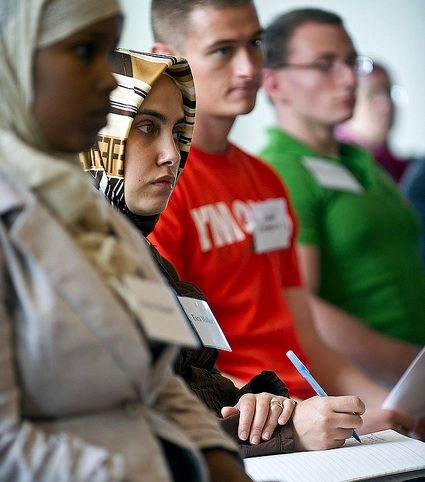
Did you know that community colleges educate nearly half of the undergraduate-level higher education students in the U.S.? It’s probably news to most of us, but it makes sense. Community colleges are local, accessible, and flexible. They’re also relatively inexpensive; compare the $3,130 average annual tuition and fees of public, in-district community colleges to in-state tuition and fees that average $8,660 per year for four-year public colleges.
To Deborah Rappaport of the Rappaport Family Foundation (RFF), community colleges are also repositories of young people who foundations can assist to be more productively involved in civic engagement efforts on campus and in their surrounding communities. The foundation now has three years of experience in this work and it is sharing its findings with other funders and the general public to promote awareness of the civic engagement potential at community colleges and the appetite for this engagement among community college students.
The Rappaport Family Foundation has long been committed to increasing civic engagement and has previously focused on non-college youth and young people in the military. But in more recent years, the foundation has discovered that it had missed a “silent majority of young people,” in Rappaport’s words, by failing to work with community college students. “So we basically did a hard stop,” Rappaport says. “We did some research, looked at who these people were, and discovered almost that nobody was doing anything” regarding civic engagement of community college students. At this point, Rappaport’s mission and passion is a California-based program called the RFF Spark Initiative, which promotes said civic engagement among the state’s community college students. The word “passion” is often overused in nonprofit and philanthropic circles, but it is exactly the right word to characterize Rappaport’s dedication to the Spark Initiative.
Why Community Colleges Are Ideal Hubs of Civic Engagement
There is a probably an unintentional bias in the nonprofit sector, and perhaps in the U.S. in general, to think of college students as those attending four-year universities and colleges. Rappaport describes the demographics of community college students in California as those students who are “overwhelmingly from struggling lower income families and communities.” In contrast to most four-year students, who often attend college as an automatic next step upon graduating from high school, Rappaport says that community college students “are among the most dedicated, hardworking, and intelligent…[because] they had to make an absolutely proactive decision in their lives that this was worth struggling for…[and] that this is what they wanted to do.”
According to the most recent community college data, there are approximately 2.8 million full-time and approximately four million part-time students attending the nation’s 1,167 community colleges. Rappaport sees these millions of community college students as having made an affirmative decision to seek a higher education degree and “to want to make a change in the communities where they live and where they go to school.”
In working with community college students, the Rappaport Family Foundation is focusing on a very distinctive higher education population. For one thing, a majority of community college students attend school on a part-time basis. Moreover, consider that 40 percent of community college students are a part of the first generation to attend college in their family. Also, 16 percent are single parents, and 12 percent are persons with disabilities. The vast majority of community college students—80 percent of full-time students and 87 percent of part-time students—work while they are in school. With an average age of 28 and a median age of 23, they tend to be older than students at four-year colleges. As one might imagine, then, some of their needs and concerns are different than those that many Americans associate with the “typical” college student.
These needs and concerns are addressed in the profile of Rappaport Family Foundation civic engagement initiatives: immigrant rights for community college students, a resource center for immigrant students, free public transportation for community students, voter registration services, etc. “One of the great things about this population [is that] they go to school where they live or have lived and they stay,” Rappaport notes. She says this makes their engagement efforts “much more community-based,” emphasizing “activism [about] what is affecting their grandparents and neighbors and peers.” That’s the point of civic engagement, right?
To date, the Rappaport Family Foundation hasn’t put a huge amount of money into this program, relatively speaking. It has only delivered $800,000 for these initiatives so far, but that sum has come in the form of small grants that have sparked projects of clear utility to the community college students behind them. Here is Rappaport’s list of Spark Initiative grantees and their programs:
|
Grantees |
2010–2011 Activities & Accomplishments |
2011–2012 Activities & Accomplishments |
2012–2013 Activities & Accomplishments |
|
|
Seeded the creation of SMAC’s educational equity campaign. Won priority registration for SFUSD students |
|
|
|
DeAnza Institute for Community & Civic Engagement |
|
|
|
|
Mobilize.org |
|
n/a |
n/a |
|
CalPIRG Education Fund |
|
|
n/a |
|
Campaign for College Opportunity |
|
|
|
|
The Democracy Commitment |
|
|
|
|
New Organizing Institute’s New Organizing University |
|
|
|
|
Young Invincibles Sign up for our free newslettersSubscribe to NPQ's newsletters to have our top stories delivered directly to your inbox. By signing up, you agree to our privacy policy and terms of use, and to receive messages from NPQ and our partners. |
|
|
tbd |
|
Roosevelt Institute’s Campus Network |
|
|
|
|
Californians For Justice |
|
|
|
|
|
$160,000 |
$280,000 |
$360,000 |
Profiles in Community College Civic Engagement Success
What do these programs mean to the community college students involved with them? For City College of San Francisco graduate Veronica Garcia, working with Students Making a Change (SMAC) was a chance to advocate for policy reform. A big issue for community college students in California, which claims one-fifth of the nation’s community college students, is the placement test; the test basically dictates how long students will have to take courses in English and math in order to graduate. The SMAC students initiated a campaign to show that the placement test was antiquated and should be revised.
Garcia and the ten to twelve other key activists at SMAC initiated what she called “a full on campaign” of students signing petitions and making their case to the City College board of trustees. Succeeding in getting a revised placement test policy was only one of SMAC’s achievements during its RFF funding. Information provided by the foundation indicates that SMAC’s advocacy helped in securing priority registration for San Francisco Unified School District graduates, the creation of a Filipino Retention Program, and a resource center for AB540 students (undocumented immigrant students in California’s version of the DREAM Act).
But civic engagement isn’t simply a matter of “victories.” It is a matter of giving community college students a sense of their ability to effectuate change in their communities and their own lives. Garcia says that before she got involved with SMAC, “I really wanted to drop out because I was really discouraged.” She describes going to SMAC meetings and seeing herself develop into a leader that was able to “be an agent of change.” Seeing community college as her community, it isn’t surprising to learn that Garcia now wants to go to graduate school to become a counselor at a community college.
Like Garcia, Elitininanesi Mafua’ofa worked with SMAC at City College of San Francisco. Part of Mafua’ofa’s experience with SMAC entailed sharing stories about what it was like to be a person of color or a part of the LGBT community at City College and what was needed to improve conditions. On Facebook, SMAC is described as focused on “building power through organizing and advocacy to improve our lives and our school.” The SMAC slogan reverberates with the enthusiasm of people who understand the importance of civic engagement: “The best way to save the college is to fix it!” For Mafua’ofa, that means learning to speak up at City College board meetings, because, as Mafua’ofa says, board members “don’t really know the struggle we’re going through now but it’s up to us to let them know.”
Aside from the placement test update, the fixes reported by Mafua’oa include getting the school to back off on a plan to raise student parking fees and increased student participation in accreditation workgroups. The SMAC Facebook page reads, “We love our college so much, we want it to be better than ever! … Last semester SMAC surveyed HUNDREDS OF STUDENTS and a SUPER MAJORITY named Accreditation as their TOP PRIORITY, so we made it our top priority, too; SMAC is doing everything possible to ensure that CCSF stays open and becomes an institution that truly puts the needs of its students FIRST.”
College of Alameda graduate Susan Manzi presents another success story. Manzi worked with the Millennial Project of the New Organizing Institute, a program focused on a series of online seminars with Harvard professor Marshall Ganz, who was teaching techniques of organizing and civic engagement. Manzi had gone back to school after ten years of being out and says she discovered how much support community college students need. She says she found out about the Millennial Project “by happenstance,” but the seminars helped encourage Manzi and others to start a number of different organizing projects and campaigns.
Manzi reports that she worked on an anti-stigma campaign for people with mental health issues. She says others worked with young mothers going to school and a group of Millennial Project colleagues at a community college in Napa worked on public health issues. Manzi says that the seminars and projects gave the participants practical skills to design and implement projects and to “craft your own stories to be a stronger leader.” She now sees herself continuing her studies, going into the community development field, and using her skills to help communities organize and implement civic engagement programs. Manzi, Garcia, and Mafua’ofa all spoke with a palpable and authentic enthusiasm about their projects. In Manzi’s words, the Spark Initiative experience was “one of the most powerful educational experiences that I have had.”
Little Foundation, Big Idea: Ripe for Replication?
Like the civic engagement that the Rappaport Family Foundation supports, there is something equally authentic and accessible about the foundation’s style of operation. The grants are not big. Typically, they’re in the range of $40,000 per organization per year. Rappaport’s perspective is that the foundation is making seed grants in the hope that these civic engagement “experiments” will show some “proof of concept” and be able to attract, with the family foundation’s help, other sustaining funders. The Rappaport Family Foundation’s niche, Rappaport says, involves telling grantees, “We want to support you in every way we can, but we’re not investment bankers.”
Who or what is this foundation that is working with the Spark Initiative grantees? “Me and my vice president and the administrative assistant,” Rappaport answers. Without a lot of money to give away, the foundation isn’t spending much money on its own bureaucratic process. On the other hand, the foundation spends personal time with the grantees. “We’re working with people who have never written a grant application,” Rappaport explains. “I try to walk a fine line—being as supportive as I can, but also trying to be almost a teacher for these young people.”
After three years, Rappaport hasn’t recruited a third-party evaluator to affirm or challenge her sense that things are working. At this point, she doesn’t think that there is enough of a funding database to warrant an external evaluation. Still, Rappaport works with Spark Initiative grantees to build their own, authentic performance metrics into the process. In her first conversations with grantees, she tells them, “if you keep hitting your marks, we will help you, we will introduce you to people, [and] we will help you replace our funding in 36 months.” After that point, the foundation is out.
Because the foundation stays very close to the grantees, Rappaport suggests that the groups are successful within a narrow definition. That is, the groups have done what they set out to do, based on metrics that they—with the foundation’s help—have defined for themselves. This isn’t a top-down foundation imposition of external metrics. Rather, Rappaport helps grantees figure out and articulate what they themselves want to achieve. After three years, she has a sense of what works. For example, she says that the most successful programs the foundation has funded “are those that are based on campus and [that] have some relationship to the pedagogy that goes on there.” She has found that each project works to the extent that it gives community college students the wherewithal to affect their college/community environments.
Rappaport hasn’t had success in getting other funders to replicate the Spark Initiative in other states—yet—but she is confident that other funders can bolster community college civic engagement elsewhere. If so, this tiny foundation is doing something with a small grant portfolio that could make a significant impact on a huge sector—something like half of all higher education students in America. It all flows from a couple simple but important ideas. One is the idea that when grantees are directly engaged and given support, they will be able to identify what it might be feasible to take on and achieve. The other idea is the notion that citizens should be able to exercise their power to redress inequities in their lives and communities via groups of mutual support.
“I know this works,” she says.
Rappaport seems to have touched on something important. In the modern Internet era of grassroots advocacy organizations whose only grass is Astroturf—or whose direction comes from up high on the hilltops—Rappaport’s foundation is supporting the civic engagement of people who have big on-the-ground challenges to deal with. Those challenges might include how to raise families while attending college, how to deal with immigrant status issues, how to balance school and work, or how to afford even the low(er) tuition and related costs of attending community college. The foundation’s support for civic engagement on community college campuses has a ring of authenticity and immediacy. “They are going to be practicing their trade and profession nine to 10 hours a day,” Rappaport says of most community college students. “The rest of the time, they’re citizens who should know how to use their voice to make things better for themselves.”











